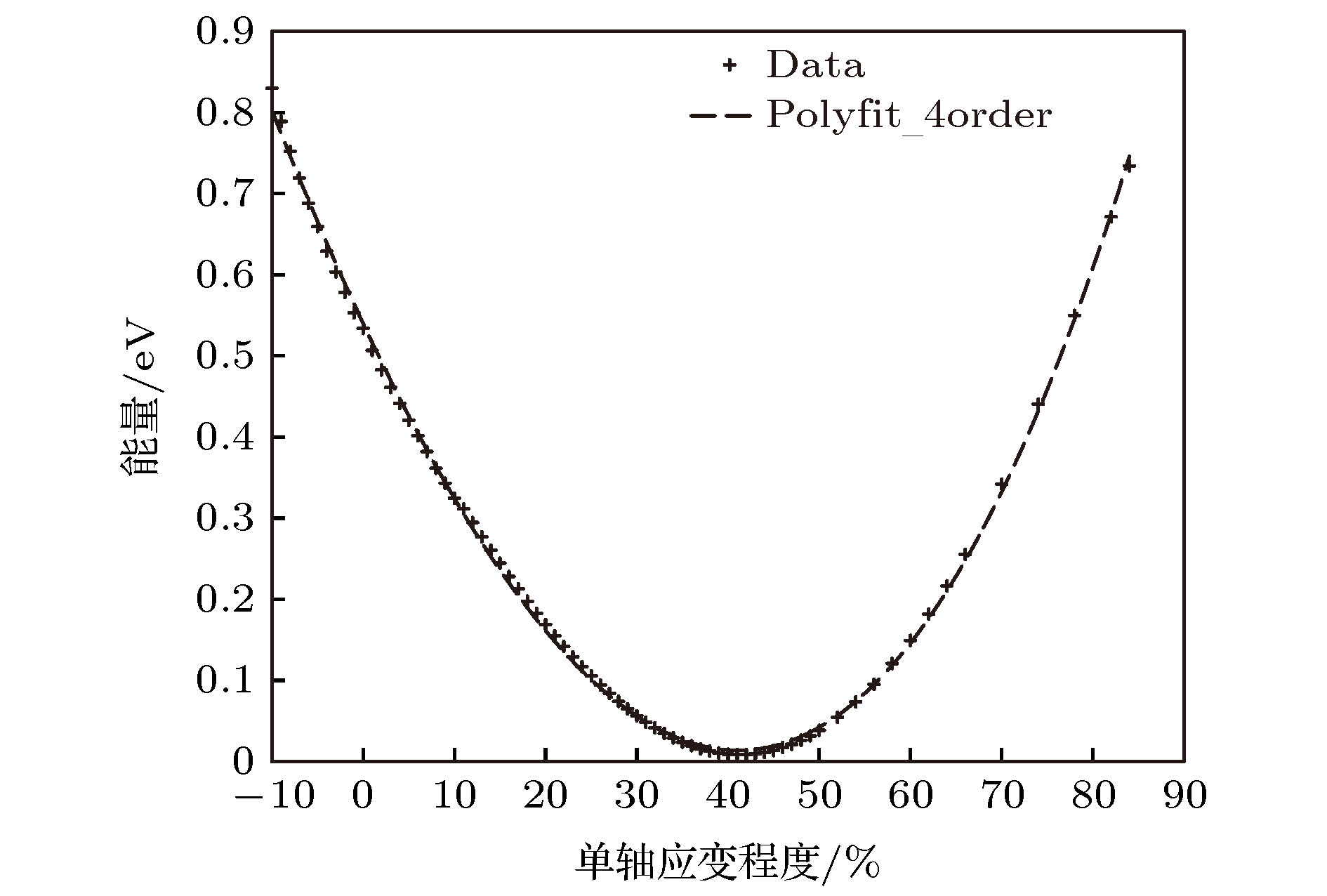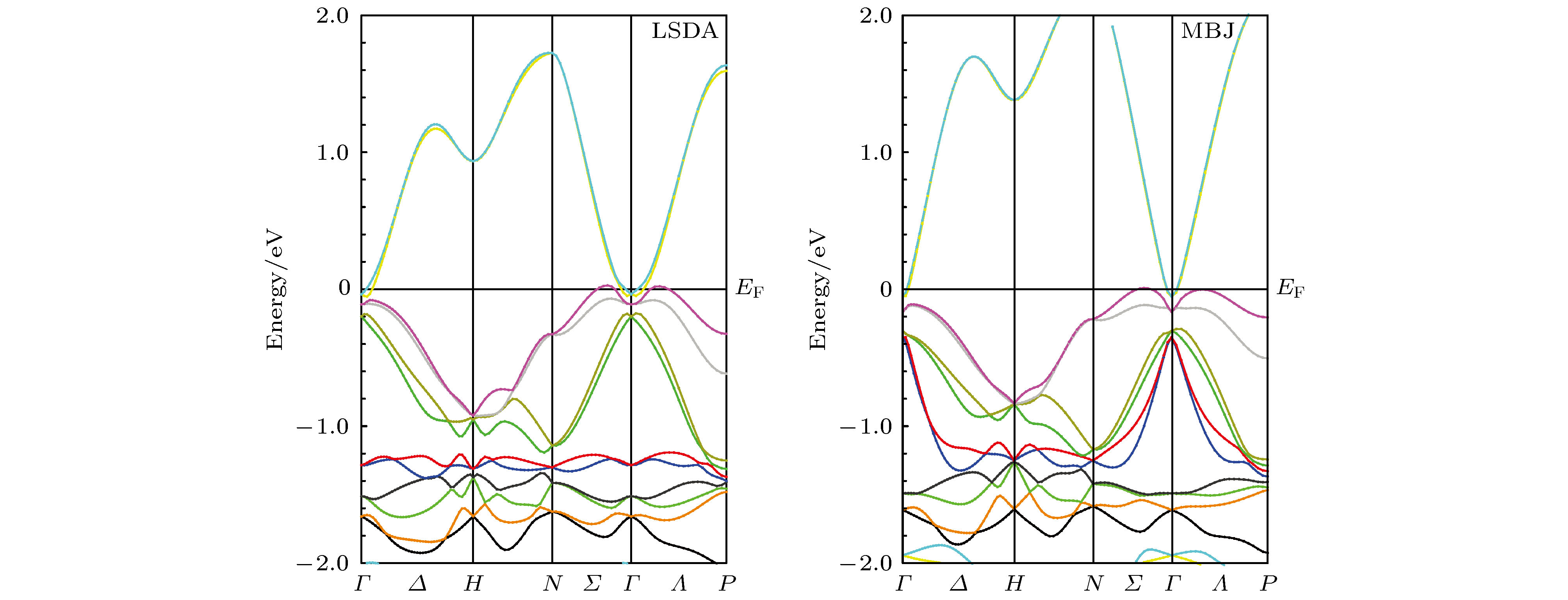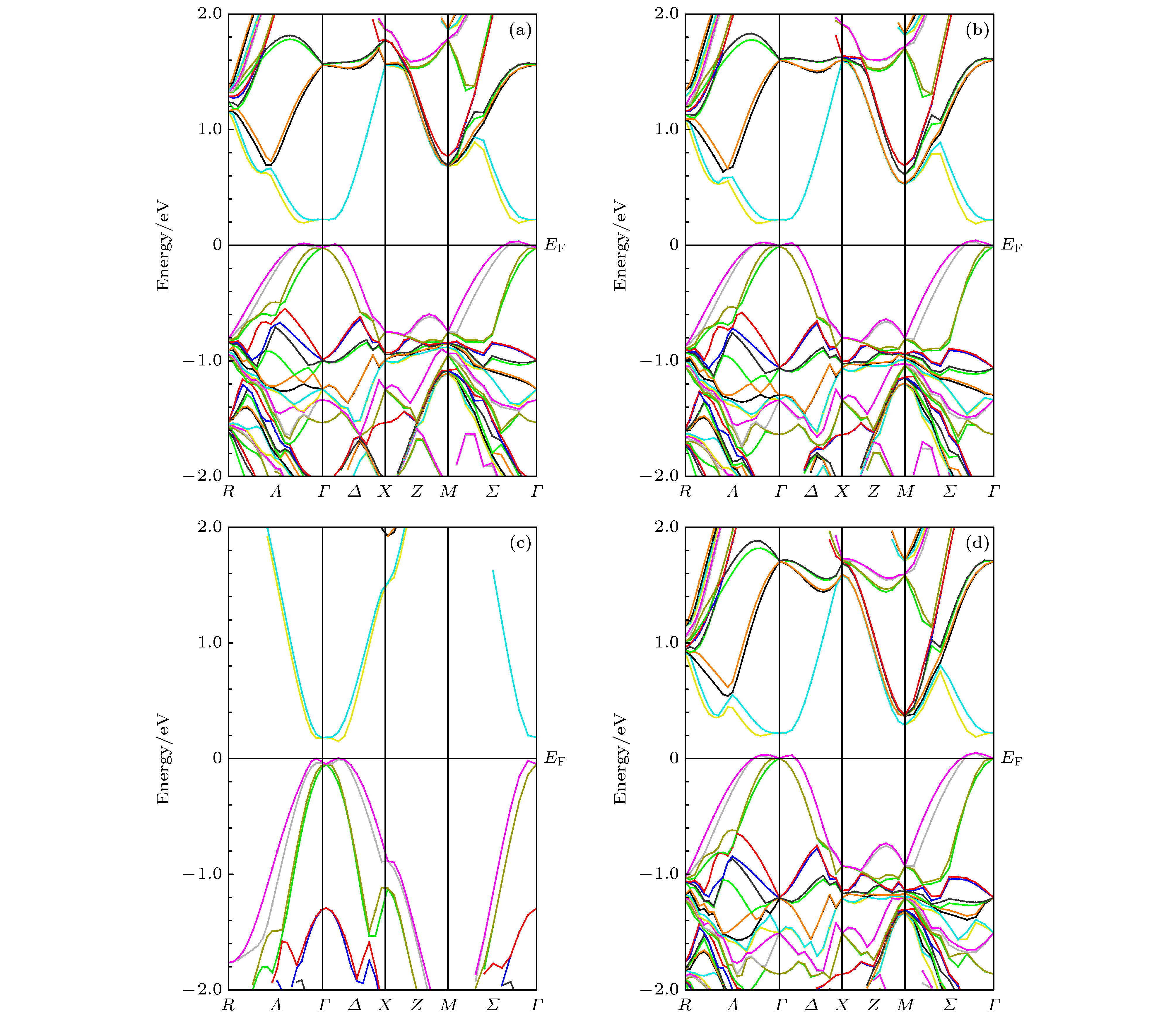-
在拓扑领域中发现可以通过大数据搜索拓扑绝缘体, 使得此领域对材料的探索转变为对材料性质的研究. 半Heusler合金体系是非平庸拓扑绝缘体材料的重要载体. 通过全势线性缀加平面波方法计算Li(Na)AuS体系拓扑绝缘体材料的能带结构. 采用各种关联泛函计算LiAuS的平衡晶格常数, 发现得到的能带图均为具有反带结构的拓扑绝缘体, 而且打开了自然带隙. 较小的单轴应力破坏立方结构后也破坏了此类拓扑绝缘体的自然带隙, 通过施加单轴拉应力直到四方结构的平衡位置时, 系统带隙值约为0.2 eV, 这与立方结构平衡位置得到的带隙结果一致. 运用同族元素替代的手段, 实现了在保证材料拓扑绝缘体性质的同时, 不改变立方结构, 在体系的平衡晶格常数下使得材料的带隙打开, 从而提高了实验合成拓扑绝缘体材料的可行性.Half-Heusler semiconductors exhibit similar properties: the differences among their properties lie only in the fact that in ternary compositions the zinc-blende binary substructure does not provide the required 18 electrons, but this is improved by adding an extra transition metal, which restores the electronic balance. Half-Heusler ternary compound with 18 valence electrons under an appropriate uniaxial strain is a topological insulating phase. Most importantly, it is proposed that in the half-Heusler family, the topological insulator should allow the incorporating of superconductivity and magnetism. Using the first-principle full-potential linearized augmented wave method we study the band structure of a series of Li(Na)AuS topological insulators. The electronic and magnetic properties of Heusler alloys are investigated by the WIEN2k package. The exchange-correlations are treated within the generalized gradient approximation of PerdeweBurke and Ernzerhof (GGA), the local spin density approximation (LSDA), by using the modified Becke-Johnson exchange potential and the correlation potential of the local-density approximation (MBJ). Spin-orbit coupling is treated by means of the second variational procedure with the scalar-relativistic calculation as basis. We first determine the equilibrium lattice constants by calculating the total energy. The theoretical lattice constant of LiAuS full-potential GGA is 6.02 Å, which is somewhat greater than the result of pseudopotential(5.99 Å). The calculated equilibrium lattice parameter is 5.86 Å for LSDA. Most of the half-Heusler compounds have band inversion, and open the nature band gaps, but the gap of MBJ is not very good. Smaller uniaxial stress damages the cubic structure and also such a natural band gap of topological insulators. By applying uniaxial tensile stress until the equilibrium position is reached in all directions of the structure, the system band gap value is about 0.2 eV, which is consistent with the result obtained from the band gap of cubic structure equilibrium position. When uniaxial tensile stress is 41%, the system turns into a tetragonal structure, the equilibrium lattice constant is a = 5.2477 Å and c/a = 1.41. We use the method of substitution of homologous elements to ensure the properties of topological insulator of materials without changing the cubic structure, and open the bandgap of materials under the equilibrium lattice constant of the system, thereby improving the feasibility of experimental synthesis of topological insulator materials. Our results for the doping suggest that epitaxial strain encountered during experiment can result in electronic topological transition. We hope that the results presented here conduce to further experimental investigation of the electronic topological transition in half-Heusler compounds.
-
Keywords:
- topological insulators /
- Heusler alloys /
- first principle /
- band structure
[1] Tang F, Po H C, Vishwanath A, Wan X 2019 Nature 566 486
 Google Scholar
Google Scholar
[2] Zhang T, Jiang Y, Song Z, Huang H, He Y, Fang Z, Weng H, Fang C 2019 Nature 566 475
 Google Scholar
Google Scholar
[3] Feng W, Xiao D, Zhang Y, Yao Y 2010 Phys. Rev. B 82 235121
 Google Scholar
Google Scholar
[4] Zhang X 2018 Chin. Phys. B 27 127101
 Google Scholar
Google Scholar
[5] Shi F, Si M S, Xie J, Mi K, Xiao C, Luo Q 2017 J. Appl. Phys. 122 215701
 Google Scholar
Google Scholar
[6] Zhang X M, Xu G Z, Du Y, Liu E K, Liu Z Y, Wang W H, Wu G H 2014 J. Appl. Phys. 115 083704
 Google Scholar
Google Scholar
[7] Chadov S, Qi X, Kübler J, Fecher G H, Felser C, Zhang S C 2010 Nat. Mater. 9 541
 Google Scholar
Google Scholar
[8] Lin H, Wray L A, Xia Y, Xu S, Jia S, Cava R J, Bansil A, Hasan M Z 2010 Nat. Mater. 9 546
 Google Scholar
Google Scholar
[9] Yang H, Yu J, Parkin S S P, Felser C, Liu C X, Yan B 2017 Phys. Rev. Lett. 119 136401
 Google Scholar
Google Scholar
[10] Xiao D, Yao Y G, Feng W, Wen J, Zhu W, Chen X Q, Stocks G M, Zhang Z 2010 Phys. Rev. Lett. 105 096404
 Google Scholar
Google Scholar
[11] Xu G, Wang W, Zhang X, Du Y, Liu E, Wang S, Wu G, Liu Z, Zhang X X 2014 Sci. Rep. 4 5709
[12] Wang W, Du Y, Xu G, Zhang X, Liu E, Liu Z, Shi Y, Chen J, Wu G, Zhang X X 2013 Sci. Rep. 3 2181
 Google Scholar
Google Scholar
[13] Zhang X M, Xu G Z, Liu E K, Liu Z Y, Wang W H, Wu G H 2015 J. Appl. Phys. 117 045706
 Google Scholar
Google Scholar
[14] Zhang X M, Wang W H, Liu E K, Liu G D, Liu Z Y, Wu G H 2011 Appl. Phys. Lett 99 071901
 Google Scholar
Google Scholar
[15] Vidal J, Zhang X, Stevanović V, Luo J W, Zunger A 2012 Phys. Rev. B 86 075316
 Google Scholar
Google Scholar
[16] Lin S Y, Chen M, Yang X B, Zhao Y J, Wu S C, Felser C, Yan B 2015 Phys. Rev. B 91 094107
 Google Scholar
Google Scholar
[17] Ding G, Gao G Y, Yu L, Ni Y, Yao K 2016 J. Appl. Phys. 119 025105
 Google Scholar
Google Scholar
[18] Barman C K, Alam A 2018 Phys. Rev. B 97 075302
 Google Scholar
Google Scholar
[19] Wang G, Wei J 2016 Comput. Mater. Sci. 124 311
 Google Scholar
Google Scholar
[20] 张小明, 刘国栋, 杜音, 刘恩克, 王文洪, 吴光恒, 柳宗元 2012 61 123101
 Google Scholar
Google Scholar
Zhang X M, Liu G D, Du Y, Liu E K, Wang W H, Wu G H, Liu Z Y 2012 Acta Phys. Sin. 61 123101
 Google Scholar
Google Scholar
[21] 王啸天, 代学芳, 贾红英, 王立英, 张小明, 崔玉亭, 王文洪, 吴光恒, 刘国栋 2014 63 053103
 Google Scholar
Google Scholar
Wang X T, Dai X F, Jia H Y, Wang L Y, Zhang X M, Cui Y T, Wang W H, Wu G H, Liu G D 2014 Acta Phys. Sin. 63 053103
 Google Scholar
Google Scholar
[22] 王啸天, 代学芳, 贾红英, 王立英, 刘然, 李勇, 刘笑闯, 张小明, 王文洪, 吴光恒, 刘国栋 2014 63 023101
 Google Scholar
Google Scholar
Wang X T, Dai X F, Jia H Y, W L Y, Liu R, Li Y, Liu X C, Zhang X M, Wang W H, Wu G H, Liu G D 2014 Acta Phys. Sin. 63 023101
 Google Scholar
Google Scholar
-
-
[1] Tang F, Po H C, Vishwanath A, Wan X 2019 Nature 566 486
 Google Scholar
Google Scholar
[2] Zhang T, Jiang Y, Song Z, Huang H, He Y, Fang Z, Weng H, Fang C 2019 Nature 566 475
 Google Scholar
Google Scholar
[3] Feng W, Xiao D, Zhang Y, Yao Y 2010 Phys. Rev. B 82 235121
 Google Scholar
Google Scholar
[4] Zhang X 2018 Chin. Phys. B 27 127101
 Google Scholar
Google Scholar
[5] Shi F, Si M S, Xie J, Mi K, Xiao C, Luo Q 2017 J. Appl. Phys. 122 215701
 Google Scholar
Google Scholar
[6] Zhang X M, Xu G Z, Du Y, Liu E K, Liu Z Y, Wang W H, Wu G H 2014 J. Appl. Phys. 115 083704
 Google Scholar
Google Scholar
[7] Chadov S, Qi X, Kübler J, Fecher G H, Felser C, Zhang S C 2010 Nat. Mater. 9 541
 Google Scholar
Google Scholar
[8] Lin H, Wray L A, Xia Y, Xu S, Jia S, Cava R J, Bansil A, Hasan M Z 2010 Nat. Mater. 9 546
 Google Scholar
Google Scholar
[9] Yang H, Yu J, Parkin S S P, Felser C, Liu C X, Yan B 2017 Phys. Rev. Lett. 119 136401
 Google Scholar
Google Scholar
[10] Xiao D, Yao Y G, Feng W, Wen J, Zhu W, Chen X Q, Stocks G M, Zhang Z 2010 Phys. Rev. Lett. 105 096404
 Google Scholar
Google Scholar
[11] Xu G, Wang W, Zhang X, Du Y, Liu E, Wang S, Wu G, Liu Z, Zhang X X 2014 Sci. Rep. 4 5709
[12] Wang W, Du Y, Xu G, Zhang X, Liu E, Liu Z, Shi Y, Chen J, Wu G, Zhang X X 2013 Sci. Rep. 3 2181
 Google Scholar
Google Scholar
[13] Zhang X M, Xu G Z, Liu E K, Liu Z Y, Wang W H, Wu G H 2015 J. Appl. Phys. 117 045706
 Google Scholar
Google Scholar
[14] Zhang X M, Wang W H, Liu E K, Liu G D, Liu Z Y, Wu G H 2011 Appl. Phys. Lett 99 071901
 Google Scholar
Google Scholar
[15] Vidal J, Zhang X, Stevanović V, Luo J W, Zunger A 2012 Phys. Rev. B 86 075316
 Google Scholar
Google Scholar
[16] Lin S Y, Chen M, Yang X B, Zhao Y J, Wu S C, Felser C, Yan B 2015 Phys. Rev. B 91 094107
 Google Scholar
Google Scholar
[17] Ding G, Gao G Y, Yu L, Ni Y, Yao K 2016 J. Appl. Phys. 119 025105
 Google Scholar
Google Scholar
[18] Barman C K, Alam A 2018 Phys. Rev. B 97 075302
 Google Scholar
Google Scholar
[19] Wang G, Wei J 2016 Comput. Mater. Sci. 124 311
 Google Scholar
Google Scholar
[20] 张小明, 刘国栋, 杜音, 刘恩克, 王文洪, 吴光恒, 柳宗元 2012 61 123101
 Google Scholar
Google Scholar
Zhang X M, Liu G D, Du Y, Liu E K, Wang W H, Wu G H, Liu Z Y 2012 Acta Phys. Sin. 61 123101
 Google Scholar
Google Scholar
[21] 王啸天, 代学芳, 贾红英, 王立英, 张小明, 崔玉亭, 王文洪, 吴光恒, 刘国栋 2014 63 053103
 Google Scholar
Google Scholar
Wang X T, Dai X F, Jia H Y, Wang L Y, Zhang X M, Cui Y T, Wang W H, Wu G H, Liu G D 2014 Acta Phys. Sin. 63 053103
 Google Scholar
Google Scholar
[22] 王啸天, 代学芳, 贾红英, 王立英, 刘然, 李勇, 刘笑闯, 张小明, 王文洪, 吴光恒, 刘国栋 2014 63 023101
 Google Scholar
Google Scholar
Wang X T, Dai X F, Jia H Y, W L Y, Liu R, Li Y, Liu X C, Zhang X M, Wang W H, Wu G H, Liu G D 2014 Acta Phys. Sin. 63 023101
 Google Scholar
Google Scholar
计量
- 文章访问数: 10273
- PDF下载量: 180
- 被引次数: 0














 下载:
下载:



